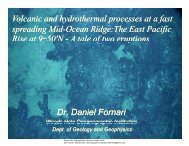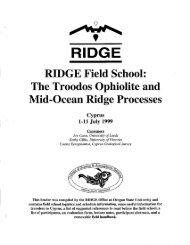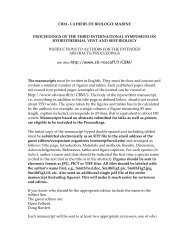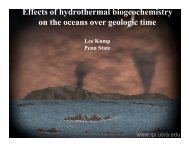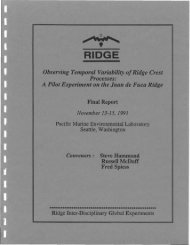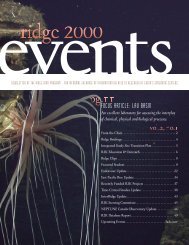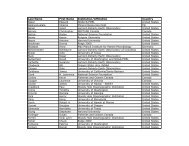Create successful ePaper yourself
Turn your PDF publications into a flip-book with our unique Google optimized e-Paper software.
instrumented to record the environmental conditions during<br />
sampling. Contamination of samples with seawater, even from the<br />
small sampler dead volumes, presently precludes a number of key<br />
measurements. Chemical sensors and procedures for making<br />
in situ measurements need to be developed, both for documenting<br />
temporal variability of active vents and to provide data free of<br />
artifacts introduced by continued reaction within discrete<br />
samplers.<br />
Strategy<br />
We advocate a balanced, three-pronged, simultaneous approach<br />
in the fi rst stages:<br />
1. Exploration, a continued search for new and varied<br />
hydrothermal systems in a wide suite of geological environments,<br />
including island arc and back-arc terrains.<br />
2. Development of new sampling tools, chemical sensors and<br />
laboratory measurement techniques needed for the investigation<br />
of diverse physical and chemical processes, together with<br />
improvements in forward modeling and inversion techniques. New<br />
tool development should include both deep and shallow drilling<br />
capabilities for a high temperature environment.<br />
3. Initial deployment of instrumentation to make temporal<br />
measurements at specific vents and characterize the principal<br />
processes. These are essential as a guide in organizing future<br />
experiments, and devising new sensor technologies and<br />
approaches.<br />
We are in the initial stages of exploration for active<br />
hydrothermal systems, and already have discovered several major<br />
seafloor sulfide deposits. We predict that additional exploration<br />
will lead to near-term discovery of seafloor hydrothermal<br />
systems of unprecedented size and intensity, which would not<br />
only produce mineral deposits of potentially economic proportions,<br />
but would also yield major perturbations of the global<br />
geochemical cycle. Other discoveries are likely in back-arc,<br />
island arc, and seamount areas, where the systems will have very<br />
different characters from those of the open oceans. Many major<br />
fossil hydrothermal deposits are in sediment-dominated systems,<br />
and exploration in such areas may be especially interesting.<br />
In parallel with the program of exploration for new systems,<br />
testing of new instruments (chemical and physical sensors) and<br />
of instrumented packages for down-hole and/or long-term deployment<br />
must begin using submersibles, drillship time, ROVs, and<br />
limited-duration bottom moorings. ROVs (remotely operated<br />
vehicles) represent a particularly exciting prospect for undersea<br />
investigation of ridge crest hydrothermal systems. In the<br />
43






